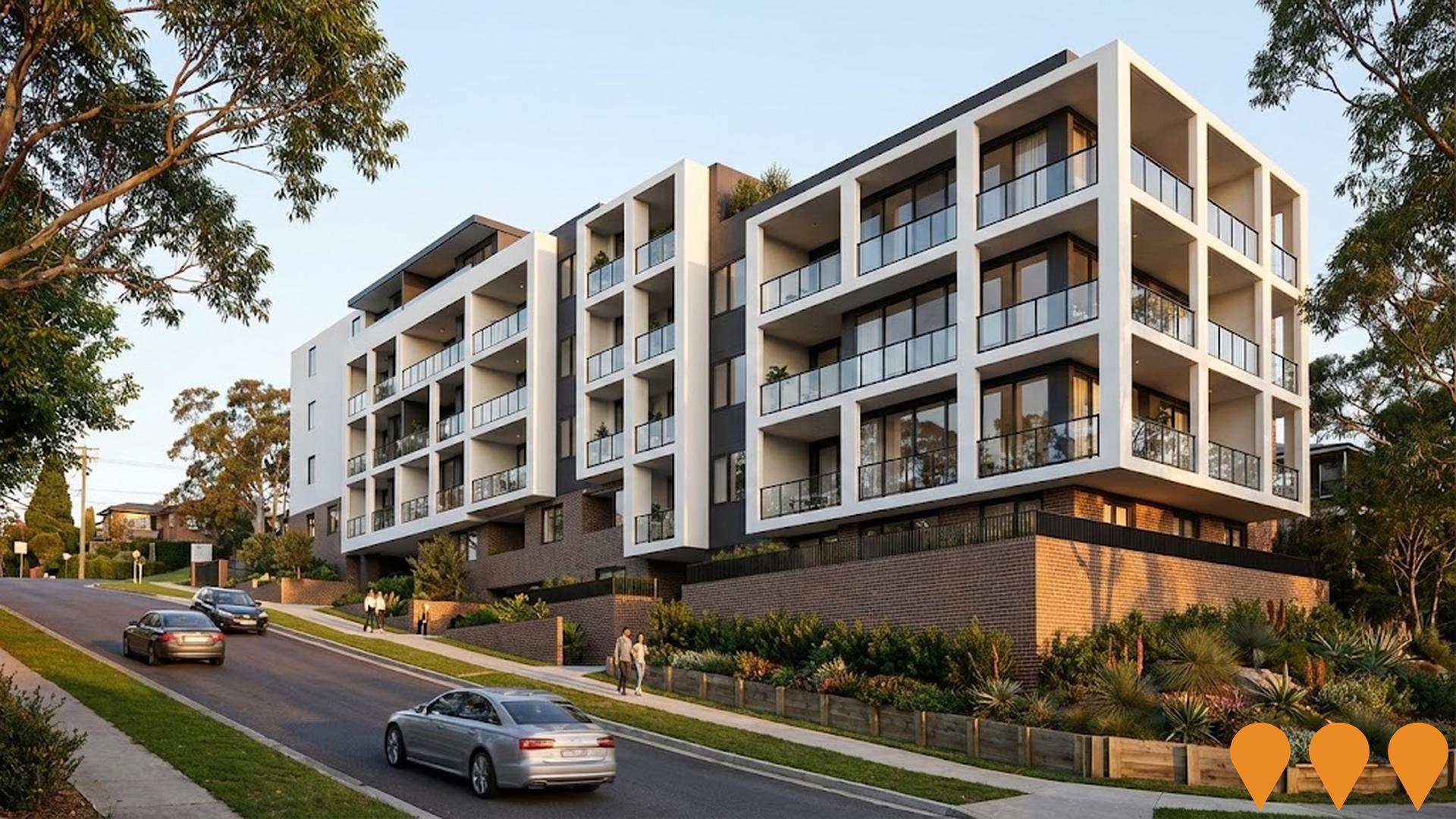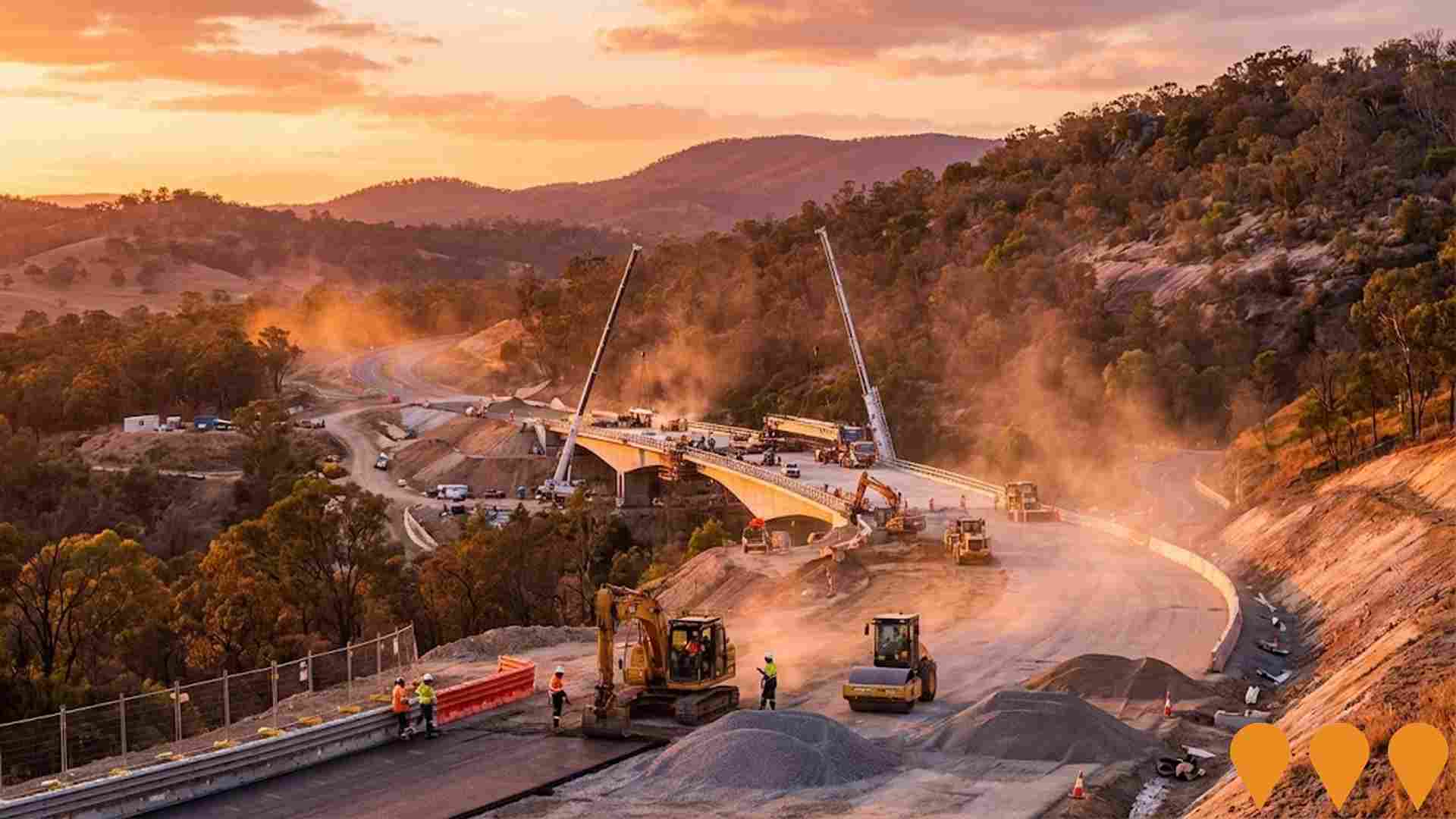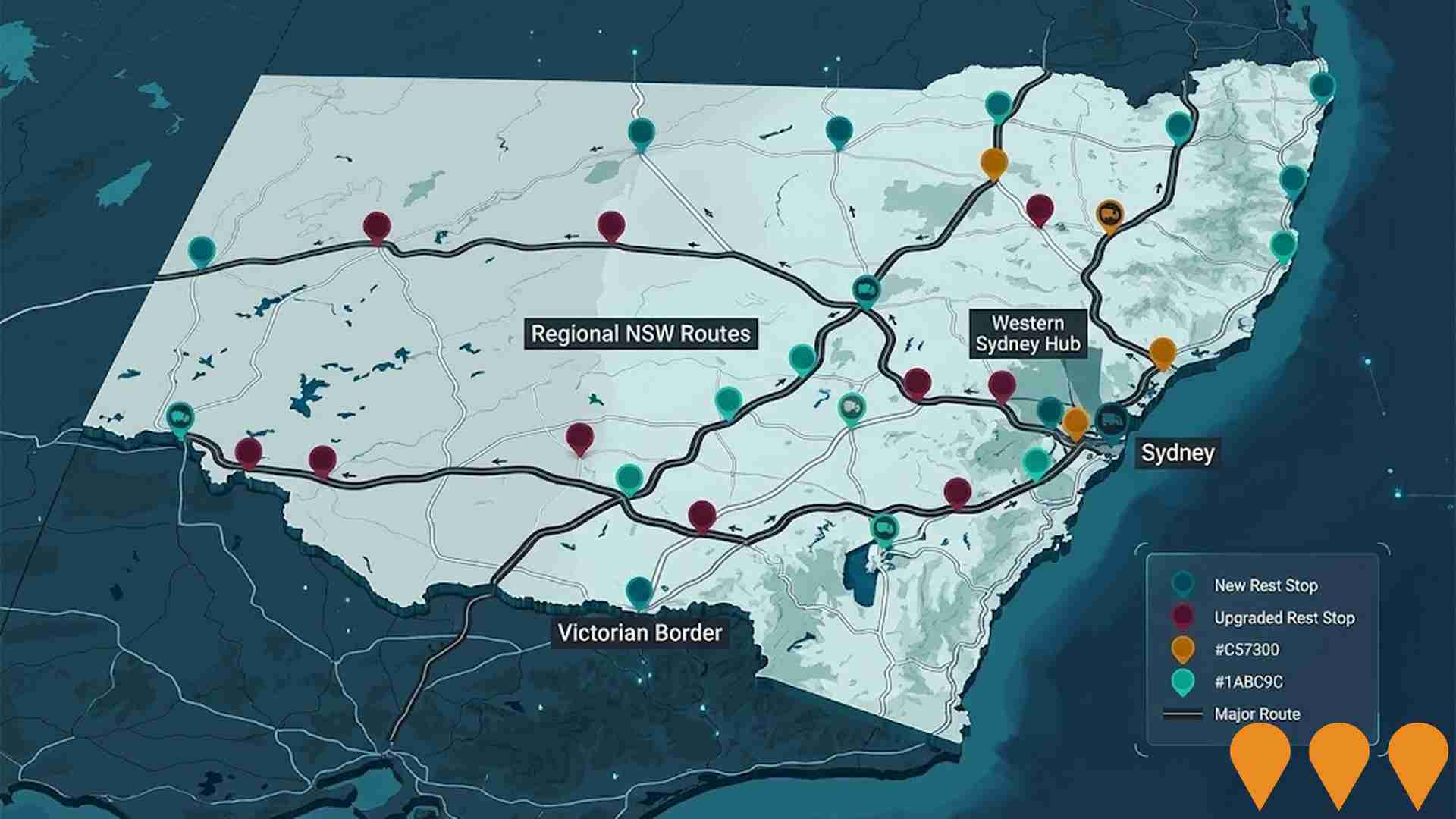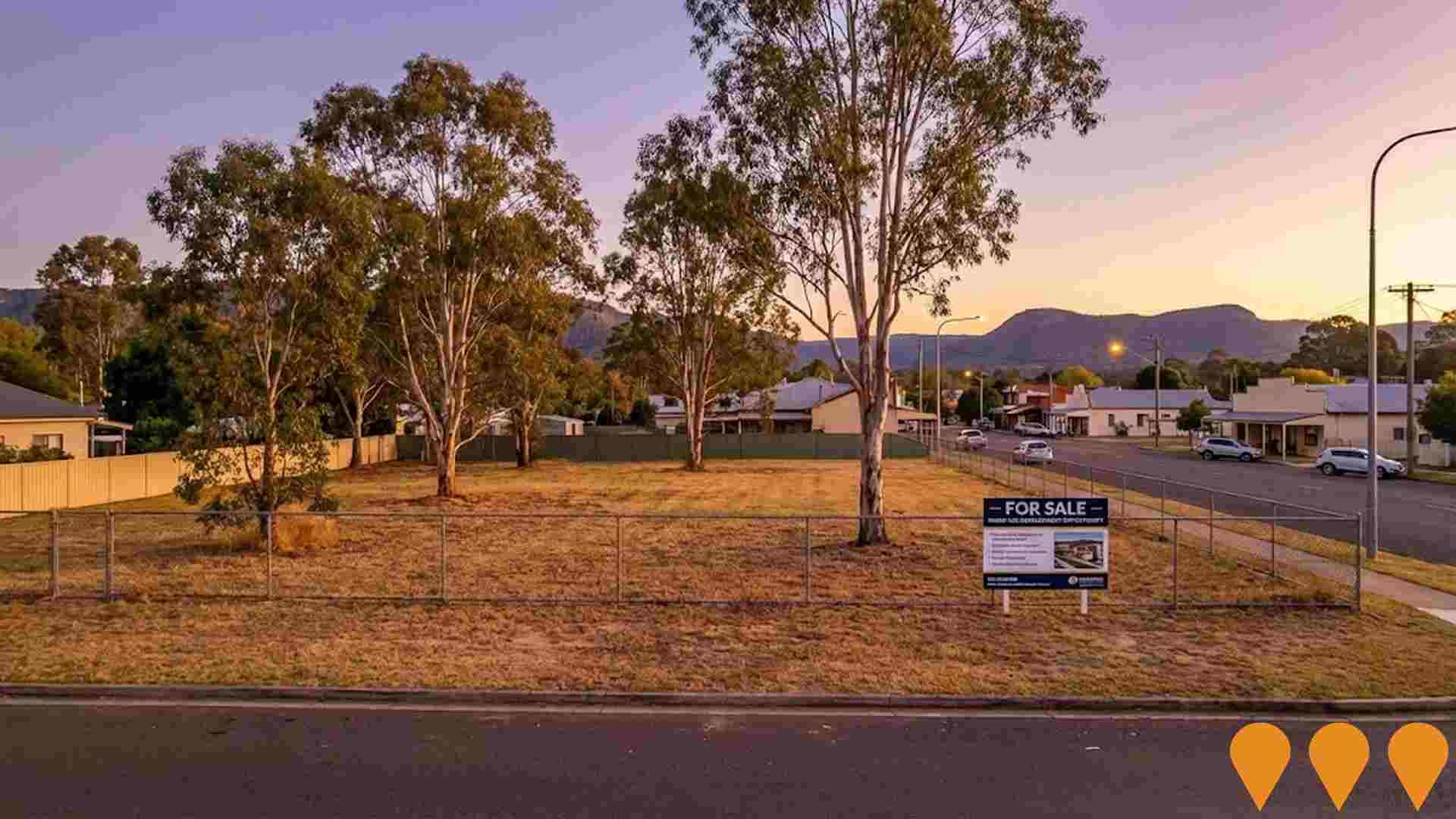Chart Color Schemes
est. as @ -- *
ABS ERP | -- people | --
2021 Census | -- people
Sales Activity
Curious about local property values? Filter the chart to assess the volume and appreciation (including resales) trends and regional comparisons, or scroll to the map below view this information at an individual property level.
Find a Recent Sale
Sales Detail
Population
An assessment of population growth drivers in Gloucester reveals an overall ranking slightly below national averages considering recent, and medium term trends
Gloucester's population is 5,414 as of August 2025, reflecting a growth of 104 people since the 2021 Census. This increase represents a 2% rise from the previous figure of 5,310. The change is inferred from ABS estimates showing an estimated resident population of 5,366 in June 2024 and an additional 47 validated new addresses since the Census date. This results in a population density ratio of 1.8 persons per square kilometer. Gloucester's growth rate of 2% since the census is within 1.8 percentage points of the SA3 area's growth rate of 3.8%. Interstate migration contributed approximately 74.3% of overall population gains during recent periods.
AreaSearch uses ABS/Geoscience Australia projections for each SA2 area, released in 2024 with a base year of 2022. For areas not covered by this data, AreaSearch utilises NSW State Government's SA2 level projections, released in 2022 with a base year of 2021. Growth rates by age group from these aggregations are applied to all areas for years 2032 to 2041. Based on projected demographic shifts, the area is expected to increase by 423 persons to 2041, reflecting a total increase of 6.9% over the 17-year period.
Frequently Asked Questions - Population
Development
Residential development activity is lower than average in Gloucester according to AreaSearch's national comparison of local real estate markets
Gloucester has granted approval annually for approximately 19 residential properties over the past five financial years, totalling 99 homes. As of FY26, two approvals have been recorded. On average, 1.6 new residents per year have arrived with each new home built between FY21 and FY25, indicating a balance between supply and demand. The average construction cost value for new dwellings was $363,000 during this period.
This financial year has seen $2.2 million in commercial approvals, suggesting minimal commercial development activity. Compared to the Rest of NSW, Gloucester shows around 75% of the construction activity per person and ranks among the 46th percentile nationally, resulting in relatively limited buyer choice. Recent construction comprises 94.0% detached houses and 6.0% medium and high-density housing, maintaining the area's traditional low density character.
The estimated population per dwelling approval is 357 people, reflecting a quiet development environment. Future projections anticipate an increase of 375 residents by 2041, with current development patterns suggesting that new housing supply should meet demand, offering favourable conditions for buyers and potentially facilitating further population growth beyond current projections.
Frequently Asked Questions - Development
Infrastructure
Gloucester has emerging levels of nearby infrastructure activity, ranking in the 34thth percentile nationally
Two projects have been identified by AreaSearch that could impact the area's performance: Mixed-Use Development Opportunity at 138 Church Street in Stratford, and the Pacific Highway Upgrade from Hexham to Brisbane.
Professional plan users can use the search below to filter and access additional projects.
INFRASTRUCTURE SEARCH
 Denotes AI-based impression for illustrative purposes only, not to be taken as definitive under any circumstances. Please follow links and conduct other investigations from the project's source for actual imagery. Developers and project owners wishing us to use original imagery please Contact Us and we will do so.
Denotes AI-based impression for illustrative purposes only, not to be taken as definitive under any circumstances. Please follow links and conduct other investigations from the project's source for actual imagery. Developers and project owners wishing us to use original imagery please Contact Us and we will do so.
Frequently Asked Questions - Infrastructure
Hunter-Central Coast Renewable Energy Zone
The Hunter-Central Coast Renewable Energy Zone (REZ) is a major infrastructure initiative designed to facilitate the transition to renewable energy in the Hunter and Central Coast regions. The project involves the construction of two new energy hubs (substations) at Sandy Creek (Muswellbrook) and Antiene (Singleton), upgrades to existing substations, and the augmentation of 85km of sub-transmission lines between Kurri Kurri and Muswellbrook. This network infrastructure will provide 1GW of additional capacity by 2028, enabling the connection of large-scale wind, solar, and battery storage projects. EnergyCo NSW serves as the infrastructure planner, with Ausgrid appointed as the network operator. Early works and site establishment commenced in 2025 following planning approval, with full network capacity expected by mid-2028. The project is expected to catalyse over $3.9 billion in investment across the region.

Low and Mid-Rise Housing Policy
State-wide NSW planning reforms via amendments to the State Environmental Planning Policy to enable more diverse low and mid-rise housing (dual occupancies, terraces, townhouses, manor houses and residential flat buildings up to 6 storeys) in well-located areas within 800 m of selected train, metro and light-rail stations and town centres. Stage 1 (dual occupancies in R2 zones statewide) commenced 1 July 2024. Stage 2 (mid-rise apartments, terraces and dual occupancies near stations) commenced 28 February 2025. Expected to facilitate up to 112,000 additional homes over the next five years.

New England Highway - Willow Tree to Uralla Safety Upgrade
Safety upgrades on the New England Highway between Willow Tree and Uralla as part of the Saving Lives on Country Roads program, including wider shoulders, wide centreline treatment, drainage upgrades, road rehabilitation, surface improvements, overtaking lanes, intersection upgrades, and shoulder sealing. Aims to improve safety by reducing run-off-road and head-on crashes, enhancing road safety and freight connectivity between Sydney and Brisbane.

Hunter Gas Pipeline
A proposed underground natural gas pipeline connecting the gas hub at Wallumbilla in Queensland to Newcastle and the Sydney market. The pipeline route passes through the Singleton local government area.

Newcastle Offshore Wind Project
The Newcastle Offshore Wind project proposes a floating wind farm off Newcastle, NSW, with an expected capacity of up to 10 gigawatts, pending a Scoping Study's results.

NSW Heavy Vehicle Rest Stops Program (TfNSW)
Statewide Transport for NSW program to increase and upgrade heavy vehicle rest stopping across NSW. Works include minor upgrades under the $11.9m Heavy Vehicle Rest Stop Minor Works Program (e.g. new green reflector sites and amenity/signage improvements), early works on new and upgraded formal rest areas in regional NSW, and planning and site confirmation for a major new dedicated rest area in Western Sydney. The program aims to reduce fatigue, improve safety and productivity on key freight routes, and respond to industry feedback collected since 2022.

Mixed-Use Development Opportunity, 138 Church Street
Vacant 1,043 m2 MU1 Mixed Use zoned block in the centre of Gloucester, currently marketed for sale as a rare development opportunity. Concept plans are available for 4 medium density residential units or townhouses, with services, fencing and road access in place and strong potential for a small mixed-use or purely residential infill project with views to the Bucketts Mountains and walkable access to shops, hospital, medical services, schools and cafes.

Stratford Renewable Energy Hub
Yancoal is proposing to develop the Stratford Renewable Energy Hub at the site of the former Stratford Mining Complex following the completion of mining in 2024. The project includes a 300 MW / 3,600 MWh pumped hydro energy storage system and a 330 MW solar farm, construction of an upper reservoir, reconfiguration of existing Stratford East Dam to act as a lower reservoir, an on-site substation. The site is zoned for heavy industrial use and has been declared Critical State Significant Infrastructure.

Employment
Gloucester has seen below average employment performance when compared to national benchmarks
Gloucester has a balanced workforce comprising white and blue collar jobs, with manufacturing and industrial sectors prominent. The unemployment rate is 3.2%, and there was estimated employment growth of 1.0% in the past year.
As of June 2025, 2,357 residents are employed, with an unemployment rate of 0.4% lower than Rest of NSW's 3.7%. Workforce participation is significantly lower at 46.3%, compared to Rest of NSW's 56.4%. Dominant employment sectors include agriculture, forestry & fishing, health care & social assistance, and construction. Gloucester specializes in agriculture, forestry & fishing, with an employment share 3.2 times the regional level.
However, health care & social assistance employs only 13.4% of local workers, below Rest of NSW's 16.9%. Employment opportunities locally may be limited, as indicated by Census data. Between June 2024 and June 2025, employment increased by 1.0%, while labour force grew by 0.7%, reducing the unemployment rate by 0.4 percentage points. In contrast, Rest of NSW saw employment decline by 0.1% and labour force growth of 0.3%, with a rise in unemployment rate by 0.4 percentage points. Jobs and Skills Australia's national employment forecasts from May 2025 project national employment growth of 6.6% over five years and 13.7% over ten years, but growth rates vary significantly between sectors. Applying these projections to Gloucester's employment mix suggests local growth of approximately 5.5% over five years and 12.0% over ten years.
Frequently Asked Questions - Employment
Income
Income metrics place the area in the bottom 10% of locations nationally according to AreaSearch analysis
Gloucester's median taxpayer income was $37,917 and average income was $47,072 in financial year 2022. This is lower than the national average of $53,687 for that year. In comparison, Rest of NSW had a median income of $49,459 and an average income of $62,998. By September 2025, based on a 12.61% growth in the Wage Price Index since financial year 2022, Gloucester's estimated median income would be approximately $42,698 and average income $53,008. According to the 2021 Census, incomes in Gloucester ranked between the 6th and 8th percentiles nationally for households, families, and individuals. The largest income segment in Gloucester comprised 29.5% of residents earning $400 - $799 weekly, contrasting with the surrounding region where 29.9% earned $1,500 - $2,999 weekly. Despite modest housing costs allowing for 88.1% income retention, total disposable income in Gloucester ranked at only the 10th percentile nationally.
Frequently Asked Questions - Income
Housing
Gloucester is characterized by a predominantly suburban housing profile, with above-average rates of outright home ownership
Gloucester's dwelling structure, as per the latest Census, consisted of 93.8% houses and 6.2% other dwellings (semi-detached, apartments, 'other' dwellings). In comparison, Non-Metro NSW had 87.7% houses and 12.3% other dwellings. Home ownership in Gloucester was at 55.7%, with the remaining dwellings either mortgaged (22.4%) or rented (21.9%). The median monthly mortgage repayment in the area was $1,300, lower than Non-Metro NSW's average of $1,430 and significantly below the national average of $1,863. The median weekly rent figure in Gloucester was recorded at $275, compared to Non-Metro NSW's $300 and substantially lower than the national figure of $375.
Frequently Asked Questions - Housing
Household Composition
Gloucester features high concentrations of lone person households, with a lower-than-average median household size
Family households account for 66.9% of all households, including 18.9% couples with children, 37.3% couples without children, and 10.0% single parent families. Non-family households constitute the remaining 33.1%, with lone person households at 30.5% and group households comprising 2.5%. The median household size is 2.2 people, which is smaller than the Rest of NSW average of 2.3.
Frequently Asked Questions - Households
Local Schools & Education
Gloucester faces educational challenges, with performance metrics placing it in the bottom quartile of areas assessed nationally
The area's university qualification rate is 14.9%, significantly lower than the NSW average of 32.2%. This presents both a challenge and an opportunity for targeted educational initiatives. Bachelor degrees are the most common at 10.2%, followed by postgraduate qualifications (2.6%) and graduate diplomas (2.1%). Vocational credentials are prevalent, with 42.0% of residents aged 15+ holding such qualifications - advanced diplomas at 10.0% and certificates at 32.0%.
A total of 24.3% of the population is actively engaged in formal education, including 9.4% in primary, 7.7% in secondary, and 2.1% in tertiary education. The area's five schools have a combined enrollment of 682 students, operating under typical Australian school conditions (ICSEA: 961) with balanced educational opportunities. Education provision is balanced with four primary and one secondary school serving distinct age groups.
Frequently Asked Questions - Education
Schools Detail
Nearby Services & Amenities
Transport
Transport servicing is low compared to other areas nationally based on assessment of service frequency, route connectivity and accessibility
Gloucester has 23 active public transport stops offering a mix of train and bus services. These are served by 11 routes providing 577 weekly passenger trips in total. Transport accessibility is limited with residents typically located 1215 meters from the nearest stop.
Service frequency averages 82 trips per day across all routes, equating to approximately 25 weekly trips per individual stop.
Frequently Asked Questions - Transport
Transport Stops Detail
Health
Health performance in Gloucester is well below average with prevalence of common health conditions notable across both younger and older age cohorts
Gloucester faces significant health challenges, with common conditions prevalent across both younger and older age groups. Private health cover is low at approximately 46%, covering around 2,490 people, compared to the national average of 55.3%.
The most prevalent medical conditions are arthritis (11.6%) and mental health issues (8.5%). Approximately 60% of residents report no medical ailments, slightly higher than the Rest of NSW's 57.7%. Around 35.3%, or 1,911 people, are aged 65 and over, higher than the Rest of NSW's 30.4%. Health outcomes among seniors in Gloucester exceed average levels, even outperforming the general population in health metrics.
Frequently Asked Questions - Health
Cultural Diversity
The latest Census data sees Gloucester placing among the least culturally diverse areas in the country when compared across a range of language and cultural background related metrics
Gloucester had a cultural diversity level below average, with 91.2% of its population born in Australia, 92.1% being citizens, and 98.1% speaking English only at home. Christianity was the predominant religion in Gloucester, making up 62.4% of people, compared to 57.6% across Rest of NSW. The top three ancestry groups were Australian (34.0%), English (33.8%), and Scottish (9.6%).
Notably, Australian Aboriginal representation was higher at 5.0%, Macedonian was at 0.1%, and Samoan was also at 0.1%.
Frequently Asked Questions - Diversity
Age
Gloucester ranks among the oldest 10% of areas nationwide
Gloucester's median age is 55 years, which is higher than the Rest of NSW average of 43 years and the national norm of 38 years. The age profile shows that those aged 65-74 are particularly prominent at 18.8%, while those aged 25-34 make up only 6.4% of the population, compared to a higher percentage in the Rest of NSW. This concentration of people aged 65-74 is significantly higher than the national average of 9.4%. Between 2021 and the present, the proportion of people aged 75-84 has grown from 10.5% to 12.4%, while the percentage of those aged 5-14 has decreased from 10.6% to 9.2%, and the 45-54 age group has dropped from 11.9% to 10.8%. Looking ahead to 2041, demographic projections indicate that the number of people aged 85 and over will rise substantially by 150 individuals (68%), from 223 to 374. This demographic aging trend is expected to continue, with residents aged 65 and older accounting for 56% of projected population growth. Conversely, population declines are anticipated for the age groups 5-14 and 15-24.

